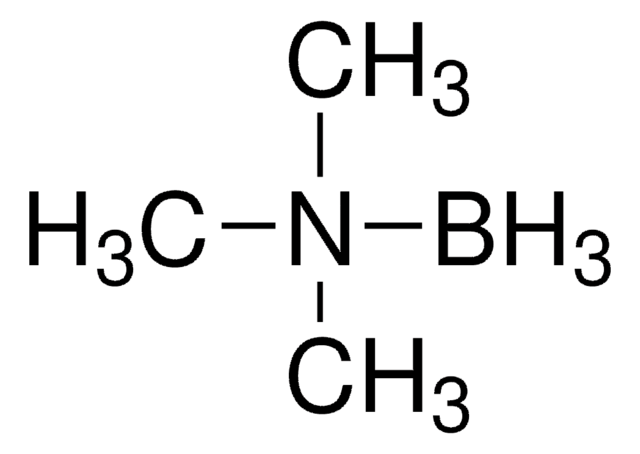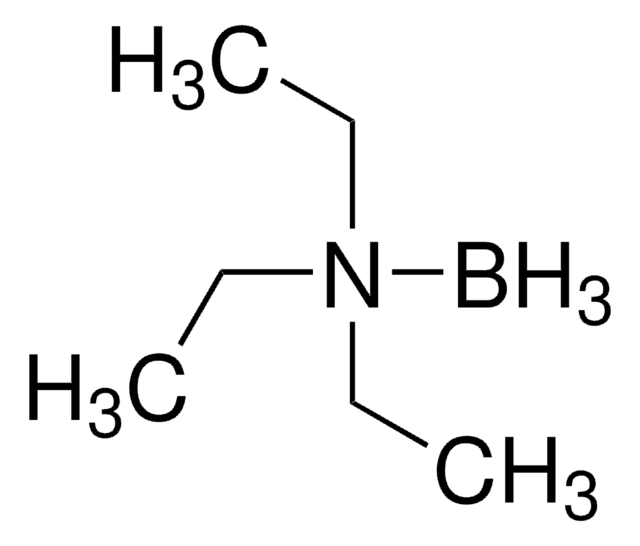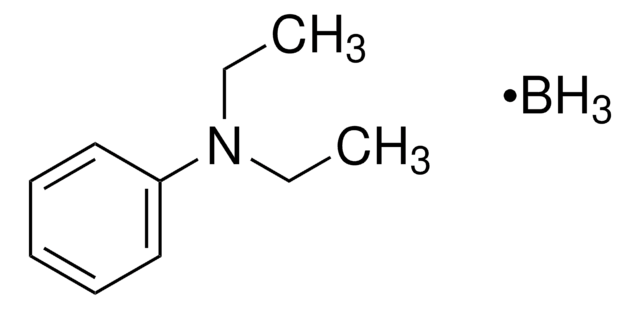Wszystkie zdjęcia(1)
Key Documents
179752
Borane pyridine complex
~8 M BH3
Synonim(y):
NSC 10219, NSC 53324, Pyridine borane, Trihydro(pyridine)boron
Zaloguj sięWyświetlanie cen organizacyjnych i kontraktowych
About This Item
Wzór empiryczny (zapis Hilla):
C5H8BN
Numer CAS:
Masa cząsteczkowa:
92.93
Numer MDL:
Kod UNSPSC:
12352005
eCl@ss:
39151701
Identyfikator substancji w PubChem:
NACRES:
NA.22
Polecane produkty
Postać
liquid
Poziom jakości
przydatność reakcji
reagent type: reductant
stężenie
~8 M BH3
współczynnik refrakcji
n20/D 1.532 (lit.)
mp
10-11 °C (lit.)
gęstość
0.92 g/mL at 25 °C (lit.)
temp. przechowywania
2-8°C
ciąg SMILES
[BH3-][n+]1ccccc1
InChI
1S/C5H8BN/c6-7-4-2-1-3-5-7/h1-5H,6H3
Klucz InChI
LPGWNCNRGQANGC-UHFFFAOYSA-N
Zastosowanie
Borane pyridine complex is commonly used as a reducing reagent for the reductive amination of aldehydes and ketones. It is the precursor to synthesize carbon-based material, BC4N. Along with iodine, it can be used as a reagent for hydroboration of alkenes and alkynes.
Used for:
Reducing agent for high performance liquid chromatography analysis of oligosaccharides
Modifier in decant oil affecting its carbonization to mesophase pitch
- Investigations of site energy distribution functions from Toth isotherm for adsorption of gases on heterogeneous surfaces
- Preparation of α−alkyl-β-hydroxy esters
- Regioselective immobilization of short oligonucleotides to acrylic copolymer gels
- Preparation of Igs conjugated with viral peptide epitopes
- Sintering of silicon carbide
Reducing agent for high performance liquid chromatography analysis of oligosaccharides
Modifier in decant oil affecting its carbonization to mesophase pitch
Przestroga
May darken in storage.
Inne uwagi
may contain excess pyridine
This page may contain text that has been machine translated.
Hasło ostrzegawcze
Danger
Zwroty wskazujące rodzaj zagrożenia
Zwroty wskazujące środki ostrożności
Klasyfikacja zagrożeń
Acute Tox. 1 Inhalation - Acute Tox. 3 Dermal - Acute Tox. 3 Oral - Eye Irrit. 2 - Flam. Liq. 2 - Skin Irrit. 2
Kod klasy składowania
3 - Flammable liquids
Klasa zagrożenia wodnego (WGK)
WGK 3
Temperatura zapłonu (°F)
69.8 °F
Temperatura zapłonu (°C)
21 °C
Wybierz jedną z najnowszych wersji:
Masz już ten produkt?
Dokumenty związane z niedawno zakupionymi produktami zostały zamieszczone w Bibliotece dokumentów.
Klienci oglądali również te produkty
A novel carbon material derived from pyridine-borane.
Riedel, Ralf et al.
Advanced Materials, 3(11), 551-552 (1991)
T Miron et al.
Analytical biochemistry, 440(1), 12-14 (2013-05-28)
In this note, we describe a method devised to detect, by means of mass spectrometry (MS), tryptophan-containing peptides and proteins using pyridine-borane. This reagent selectively reduces tryptophan residues, converting them to 2,3-dihydro-tryptophan, thereby enabling quantitation of tryptophans.
Journal of the Chemical Society. Perkin Transactions 1, 717-717 (1984)
Jethro L Hemmann et al.
Proceedings of the National Academy of Sciences of the United States of America, 116(51), 25583-25590 (2019-11-30)
Methylotrophy, the ability of microorganisms to grow on reduced one-carbon substrates such as methane or methanol, is a feature of various bacterial species. The prevailing oxidation pathway depends on tetrahydromethanopterin (H4MPT) and methylofuran (MYFR), an analog of methanofuran from methanogenic
Hydroboration with pyridine borane at room temperature.
Clay, Julia M and Vedejs, Edwin
Journal of the American Chemical Society, 127(16), 5766-5767 (2005)
Nasz zespół naukowców ma doświadczenie we wszystkich obszarach badań, w tym w naukach przyrodniczych, materiałoznawstwie, syntezie chemicznej, chromatografii, analityce i wielu innych dziedzinach.
Skontaktuj się z zespołem ds. pomocy technicznej










